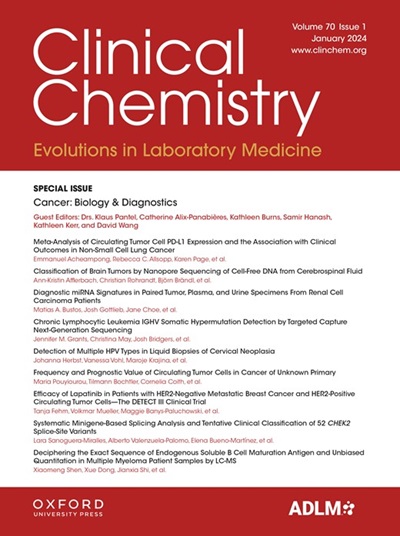在临床实验室安全有效地验证、实施和监控机器学习解决方案。
IF 7.1
2区 医学
Q1 MEDICAL LABORATORY TECHNOLOGY
引用次数: 0
摘要
背景机器学习解决方案为改善病理学临床和实验室操作带来了巨大希望。有关这些方法的概念验证描述在检验医学文献中已屡见不鲜,但其中只有极少数已在临床实验室中实施,原因是在实践中验证、实施和监控这些应用往往存在巨大障碍。特刊在临床实验室中有效、负责任地应用机器学习需要在实施前进行强有力的验证。全面的验证研究包括对研究设计、数据工程和互操作性、目标标签定义、指标选择、可推广性和适用性评估、算法公平性和可解释性的严格评估。正文概括性地强调了这些概念,同时还提供了补充代码演练,以方便读者通过一个真实世界的分类任务示例(检测受盐水污染的化学分析板)更切实地理解这些主题。实施机器学习解决方案需要企业中多个角色的跨学科努力。我们重点介绍了将经过验证的解决方案成功部署到实际生产环境中的关键角色、职责和术语。最后,必须对已实施的解决方案进行例行监控,以防出现性能下降的迹象,并在必要时进行更新。摘要本篇微型综述旨在通过强调临床实验室中有效、负责任地验证、实施和监控机器学习解决方案的关键概念,缩小理论与实践之间的差距。本文章由计算机程序翻译,如有差异,请以英文原文为准。
Validating, Implementing, and Monitoring Machine Learning Solutions in the Clinical Laboratory Safely and Effectively.
BACKGROUND
Machine learning solutions offer tremendous promise for improving clinical and laboratory operations in pathology. Proof-of-concept descriptions of these approaches have become commonplace in laboratory medicine literature, but only a scant few of these have been implemented within clinical laboratories, owing to the often substantial barriers in validating, implementing, and monitoring these applications in practice. This mini-review aims to highlight the key considerations in each of these steps.
CONTENT
Effective and responsible applications of machine learning in clinical laboratories require robust validation prior to implementation. A comprehensive validation study involves a critical evaluation of study design, data engineering and interoperability, target label definition, metric selection, generalizability and applicability assessment, algorithmic fairness, and explainability. While the main text highlights these concepts in broad strokes, a supplementary code walk-through is also provided to facilitate a more practical understanding of these topics using a real-world classification task example, the detection of saline-contaminated chemistry panels.Following validation, the laboratorian's role is far from over. Implementing machine learning solutions requires an interdisciplinary effort across several roles in an organization. We highlight the key roles, responsibilities, and terminologies for successfully deploying a validated solution into a live production environment. Finally, the implemented solution must be routinely monitored for signs of performance degradation and updated if necessary.
SUMMARY
This mini-review aims to bridge the gap between theory and practice by highlighting key concepts in validation, implementation, and monitoring machine learning solutions effectively and responsibly in the clinical laboratory.
求助全文
通过发布文献求助,成功后即可免费获取论文全文。
去求助
来源期刊

Clinical chemistry
医学-医学实验技术
CiteScore
11.30
自引率
4.30%
发文量
212
审稿时长
1.7 months
期刊介绍:
Clinical Chemistry is a peer-reviewed scientific journal that is the premier publication for the science and practice of clinical laboratory medicine. It was established in 1955 and is associated with the Association for Diagnostics & Laboratory Medicine (ADLM).
The journal focuses on laboratory diagnosis and management of patients, and has expanded to include other clinical laboratory disciplines such as genomics, hematology, microbiology, and toxicology. It also publishes articles relevant to clinical specialties including cardiology, endocrinology, gastroenterology, genetics, immunology, infectious diseases, maternal-fetal medicine, neurology, nutrition, oncology, and pediatrics.
In addition to original research, editorials, and reviews, Clinical Chemistry features recurring sections such as clinical case studies, perspectives, podcasts, and Q&A articles. It has the highest impact factor among journals of clinical chemistry, laboratory medicine, pathology, analytical chemistry, transfusion medicine, and clinical microbiology.
The journal is indexed in databases such as MEDLINE and Web of Science.
 求助内容:
求助内容: 应助结果提醒方式:
应助结果提醒方式:


